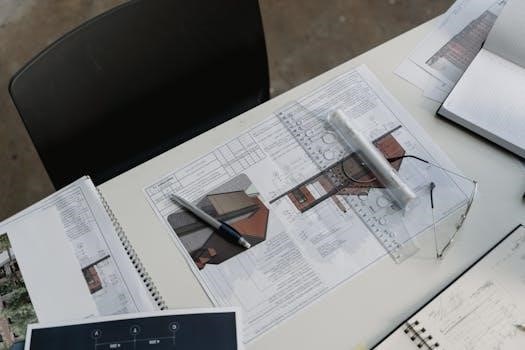AP Calculus AB Exam Structure
The AP Calculus AB exam is divided into two main sections⁚ multiple choice and free response. Section I contains 45 multiple-choice questions, split into Part A and Part B. These sections assess different skills and calculator use.
Section I⁚ Multiple Choice

The first section of the AP Calculus AB exam is the multiple-choice section. This section is further divided into two parts. Part A consists of 28 questions that must be solved without using a calculator, and Part B consists of 17 questions where a calculator is permitted. This section is designed to assess your fundamental understanding of calculus concepts and your ability to apply them in various problem-solving scenarios. Section I contains 45 multiple-choice questions and 4 survey questions. For Part A, fill in only the circles for numbers 1 through 28 on page 2 of the answer sheet. For Part B, fill in only the circles for numbers 76 through 92 on page 3 of the answer sheet. The survey questions are numbers. 93 through 96. The time allotted for this section is divided between the two parts. Part A has a specific time limit, and Part B also has its own time restriction. This section accounts for 50% of your final exam score. It tests your knowledge across the curriculum, including limits, derivatives, integrals, and the applications of calculus.

Part A⁚ No Calculator
Part A of the multiple-choice section requires you to solve 28 questions without the aid of a calculator. This segment of the AP Calculus AB exam is crucial for demonstrating your mastery of fundamental calculus principles and your ability to perform calculations by hand. The questions in this section often focus on core concepts such as limits, derivatives, and basic integration. You’ll need a solid understanding of rules and theorems. This part of the exam is designed to test your analytical skills and your understanding of calculus, rather than your ability to use a calculator. Time management is crucial for this portion, as you need to be efficient in solving problems without relying on computational tools. This section is a key component for evaluating your understanding and skill set in a fundamental way. The skills tested here are crucial for success in the rest of the exam.
28 Questions
This portion of the AP Calculus AB exam, the first part of the multiple-choice section, consists of exactly 28 questions. These questions are designed to assess your foundational calculus knowledge without the assistance of a calculator. Expect a range of problems covering various topics like differentiation, integration, limits, and applications of calculus. These questions demand a strong grasp of fundamental concepts and the ability to perform mathematical operations accurately and efficiently. Mastering techniques for solving problems by hand is crucial for success in this part. The 28 questions are carefully selected to provide a comprehensive evaluation of your understanding of the core calculus principles. Careful time management and an understanding of core concepts are critical for successfully completing all 28 questions in the allotted time. This section really highlights a test taker’s fundamental understanding.
Part B⁚ Calculator Permitted
The second part of the multiple-choice section on the AP Calculus AB exam allows the use of a graphing calculator. This part, known as Part B, features 17 questions. These questions require a different approach, emphasizing the application of calculus concepts along with the strategic utilization of calculator functions. The problems might involve numerical approximations, graphical analysis, and more complex computations that would be impractical to solve by hand. Students are encouraged to be proficient with their calculators, using them to solve problems efficiently and effectively. It is vital to understand when and how to use the calculator to your advantage, as well as to interpret the results. Time management is still crucial, and it is important to be comfortable with various calculator features.
17 Questions
The 17 multiple-choice questions in Part B of the AP Calculus AB exam are designed to assess your understanding of calculus concepts with the aid of a calculator. These questions often require a mix of analytical and computational skills. You will need to use your graphing calculator effectively to solve problems involving numerical methods, graphical analysis, and complex calculations. These questions might include finding derivatives and integrals, solving differential equations, interpreting graphs, or determining limits. Mastery of calculator functions is crucial, as is the ability to interpret its output in the context of the problem. Time management is essential, and familiarity with various calculator features will help you solve these questions efficiently. Remember, the calculator is a tool to aid your understanding, not a replacement for it. Practice with calculator-based problems is highly recommended.

AP Calculus AB Exam Free Response
The free-response section of the AP Calculus AB exam has two parts. Part A requires a calculator, and Part B does not. These questions demand detailed solutions and justifications for each answer.
Part A⁚ Calculator Required
This portion of the AP Calculus AB free-response section presents two questions that require the use of a graphing calculator. Students will have 30 minutes to complete this part. These questions often involve real-world applications of calculus concepts, such as finding areas, volumes, rates of change, and accumulation. The calculator is an essential tool for these problems, allowing for complex calculations, graphing functions, and numerical integration and differentiation. The problems are designed to test the application of calculus principles in situations where a calculator is necessary for efficient problem-solving. It is crucial to be familiar with how to use your calculator effectively to maximize your score on this portion of the exam. Careful interpretation of the question and clear notation of your calculus steps are essential, in addition to correct calculator usage. Remember to show all essential work and reasoning to receive full credit.
2 Questions, 30 minutes
In this section of the AP Calculus AB exam, you will encounter two free-response questions that must be completed within a 30-minute time limit. A graphing calculator is required for these problems. These questions are designed to assess your ability to apply calculus concepts to solve complex and multi-step problems. These often require you to use your calculator to perform numerical calculations, such as finding definite integrals, derivatives, or solving equations. You must understand how to use your calculator efficiently and accurately. The questions test your understanding of calculus concepts within the context of real-world scenarios. Be sure to clearly show all essential steps and calculations; Correctly setting up the problem and showing your work are necessary to receive full credit. Time management is important in this section.
Part B⁚ No Calculator
This portion of the AP Calculus AB exam’s multiple-choice section consists of 17 questions that must be answered without the aid of a calculator. These questions focus on testing your fundamental knowledge of calculus concepts and your ability to perform computations and algebraic manipulations by hand. You will need to be fluent in techniques such as differentiation, integration, and finding limits. You will also need to be comfortable with analytical methods, understanding graphs, and interpreting mathematical expressions. This section emphasizes conceptual understanding and your skill in applying theorems and formulas. Accuracy and speed are essential for success in this section, so practice your manual calculus skills by solving multiple problems and make sure you understand the main concepts. Time management is crucial here, as you must solve several problems quickly and efficiently without a calculator.
4 Questions, 60 minutes
The second part of the Free Response section in the AP Calculus AB exam, which is Part B, is comprised of four free-response questions that you must complete within 60 minutes. Critically, you are not permitted to use a calculator during this part of the exam. These questions are designed to assess your comprehensive understanding of calculus and your proficiency in articulating your mathematical reasoning. Each question may involve multiple parts, requiring you to demonstrate a range of skills, from setting up integrals and solving differential equations to justifying your responses with proper mathematical language. This section allows a more in-depth analysis of your calculus knowledge than the multiple choice section. Time management is key as you have 15 minutes per question. Focus on clarity, accuracy, and thoroughness in your solutions, making sure to show all necessary steps to obtain full credit.

Practice Resources
To prepare for the AP Calculus AB exam, utilize full-length practice tests, multiple-choice quizzes, and past exam questions. These resources will help you familiarize yourself with the exam format and content.
Full-Length Practice Exams
Full-length practice exams are crucial for effective preparation for the AP Calculus AB exam. These simulated tests mirror the actual exam’s structure, including the multiple-choice and free-response sections, and time constraints. Taking full-length practice exams allows you to assess your strengths and weaknesses, identify areas needing further study, and practice time management under exam conditions. You can find full-length practice exams online from various educational resources. It is essential to review your answers, understand the solutions, and analyze your mistakes. Utilizing these practice exams will boost your confidence and improve your performance on the actual AP Calculus AB exam. These exams help simulate real test conditions and offer detailed explanations for both multiple-choice and free-response questions. They also allow you to identify your weaknesses and tailor your study plan accordingly, ensuring you have a realistic gauge of your abilities before the test.
Multiple Choice Practice Quizzes
Multiple-choice practice quizzes are a vital tool for mastering the AP Calculus AB exam. These quizzes allow you to focus on specific concepts and skills assessed in the multiple-choice section. Numerous online resources provide these practice quizzes, often organized by topic or difficulty level. Regular engagement with these quizzes helps reinforce your understanding of calculus principles and improves your speed and accuracy in answering multiple-choice questions. Analyzing your mistakes after each quiz is crucial for identifying areas that need more attention. These quizzes are designed to mimic the format of the actual exam, providing valuable experience. They also provide feedback on areas of strength and weakness, allowing for targeted study sessions. By regularly engaging in multiple-choice practice quizzes, you can refine your test-taking strategies and boost your performance on the AP Calculus AB exam. These quizzes help reinforce your grasp of calculus topics and build confidence.
Past Exam Questions and Sample Answers
Utilizing past exam questions and sample answers is an essential strategy for effective preparation for the AP Calculus AB exam. Accessing released free-response questions from previous years, along with their corresponding scoring guidelines and sample student responses, offers invaluable insights into the exam’s format and expectations. These resources allow you to understand how the questions are structured, what type of reasoning is required, and how points are awarded. Reviewing the sample answers can provide a clear picture of what constitutes a well-written and accurate response. Moreover, you can use these past questions for timed practice sessions, simulating the actual exam environment. Analyzing the scoring distributions helps you gauge the difficulty level and identify the key aspects that graders are looking for. By carefully studying past exam questions and sample answers, you gain a deeper understanding of the exam’s requirements. This will improve your problem-solving skills and boost your confidence.